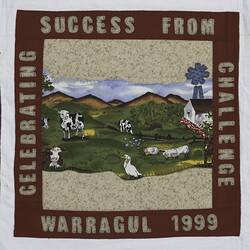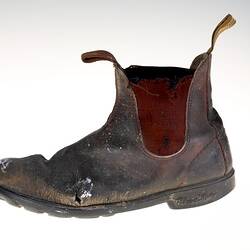Summary
An overview of the Women on Farms Gatherings and the key characteristics that define the Gatherings each year.
What is a Gathering?
Every WOFG has been different - and the same. The landscape, the rural enterprises, the sense of place, the regionalism may have a different flavour, a different face in the selection of workshop topics and tours - but the issues and concerns and celebration and pride in our contribution to our local communities permeates every Gathering. Meg Barry, organising committee member, Glenormiston Gathering (1994)
Since 1990, rural women have been meeting annually in Victoria to discuss ideas, share and learn skills, vocalise concerns about rural issues, offer and seek support, create networks, and just relax for a weekend away from the farm. While every Gathering has its own unique regional 'flavour' - often encapsulated in the theme chosen by each of the Gathering's organising committees - there are elements which have come to be expected in each year's program.
Opening Ceremony/Gathering Welcome: Since the inaugural Warragul Gathering in 1990, each Gathering has traditionally begun with an official opening ceremony, which usually includes an opening address and a formal acknowledgement of the traditional custodians of the land. Opening speakers will customarily introduce the local committee and discuss the theme for the year's Gathering.
Women's Stories and Keynote/Guest Speakers: Often heart-wrenching and frequently funny, the stories told by local women about their lives on farms are a favourite feature of every Gathering. As well as showcasing local women's stories, the Gatherings also attract speakers from across Victoria, and occasionally from interstate.
Displays: Presentations and stalls showcasing local stakeholders and service providers are commonly set up in the main 'meeting hall' of each Gathering. These are complimented by 'history boards' that convey the rich and ever-growing history of all Victorian Women on Farms Gatherings.
Workshops: Workshops are a central element of each Gathering and are spread across the weekend, usually as one or two hour session that occur both in the mornings and afternoons. Organised by the local Gathering committee, the workshops are most often run by local community members and range within, but are not limited to, the following categories:
- Farm Skills
- Arts and Crafts
- Finance
- Decision-making
- Health
- Sustainable Agriculture
- Technology
- Leadership
- Community
- Succession Planning
Tours: Local tours are offered alongside workshops and provide an excellent opportunity for the Gathering committee to showcase their region. Example tour destinations include local women's farms, historical societies, wineries, Landcare groups, heritage trails and gardens.
Gathering Dinner: A much-needed opportunity to socialise, meet new people and catch up with those met at previous Gatherings, the dinner is usually held on a Saturday night and aims to provide a light-hearted evening of entertainment and storytelling. Past Gathering dinners have featured musical performances, speeches, poetry, fashion parades and dance.
Ecumenical Service: An ecumenical service is usually held on the last morning of the Gathering weekend and women are given the opportunity to share prayers, some of which may have been written especially for this service. Attending the ecumenical service is optional; there are often other activities, such as morning yoga, occurring at the same time.
Baton Changing Ceremony: The closing of each Gathering and the anticipation of the next is celebrated with a formal 'baton changing' ritual, where a symbolic 'icon' is handed over from one organising committee to the next. Each item represents a story or message of some of the key themes and issues, which have shaped the meaning and experience of these women's rural identity.
More Information
-
Keywords
-
Localities
-
Authors
-
Article types




